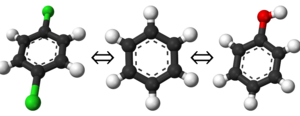Difference between revisions of "Multistate Bennett Acceptance Ratio"
m |
m |
||
| Line 4: | Line 4: | ||
Much like WHAM, the free energies provided by this method are only a statistical estimator, however, MBAR has been shown to have the lowest variance estimator to date. | Much like WHAM, the free energies provided by this method are only a statistical estimator, however, MBAR has been shown to have the lowest variance estimator to date. | ||
| + | |||
| + | =Derivation= | ||
| + | MBAR is derived from a set of <math>K \times K</math> weighting functions, <math>\alpha_{i,j}(\vec{q})</math>, that minimized the variance during the reweighting across the board. Starting from our [[Theoretic Principals#Core Free Energy Equation| core free energy equation]], we have | ||
| + | |||
| + | :<math>\displaystyle\Delta A_{ij} = -\beta^{-1} \ln\frac{Q_j}{Q_i}</math> | ||
| + | |||
| + | We can also manipulate the same identity Bennett used when starting his derivation{{Cite | Bennett1976 | Bennett, C. H. (1976) Efficient Estimation of Free Energy differences from Monte Carlo Data. ''J. Comput. Phys.'' 22, 245–268. | http://www.citeulike.org/group/14929/article/9052076}} and then a one extra bit to come up with the relation | ||
| + | |||
| + | :<math>Q_i\left\langle\alpha_{ij}\exp\left(-\beta U_j\right)\right\rangle_i = Q_j\left\langle\alpha_{ij}\exp\left(-\beta U_i\right)\right\rangle_j</math> | ||
| + | |||
| + | Although this may not seem like much, it does allow us to write out the following: | ||
| + | |||
| + | :<math>\displaystyle \sum\limits_{j=1}^K \frac{\hat{Q_i}}{N_i} \sum\limits_{n=1}^{N_i} \alpha_{ij}\exp\left(-\beta U_j(\vec{q}_{i,n})\right) = \sum\limits_{j=1}^K \frac{\hat{Q_j}}{N_j} \sum\limits_{n=1}^{N_j} \alpha_{ij}\exp\left(-\beta U_i(\vec{q}_{j,n})\right)</math> | ||
| + | |||
| + | assuming we use the empirical estimator for the expectation values of <math>\left\langle g \right\rangle_i = N_i^{-1}\sum_{n=1}^{N_i}g(\vec{q}_{i,n})</math> | ||
| + | |||
| + | Choosing the optimal <math>\alpha_{ij}</math> can be done by looking through the literature at extended bridge sampling.{{cite|Tan2004|Tan, Z. (2004). On a Likelihood Approach for Monte Carlo Integration. ''J. Am. Stat. Assoc.'', 99(468), 1027–1036.}} | ||
=Download MBAR= | =Download MBAR= | ||
Revision as of 16:57, 25 September 2012
| Free Energy Fundamentals |
|---|
 |
|
Methods of Free Energy Simulations
|
| Free Energy How-to's |
|---|
 |
The Multistate Bennett Acceptance Ratio (MBAR)[1] is a direct extension to BAR as it allow for assessing data from all states, and predicting the free energy at an unsampled state. MBAR reduces to BAR in the limit that only two states are sampled. This equation of free energy calculations can also be seen as a zero-width bin WHAM.
Much like WHAM, the free energies provided by this method are only a statistical estimator, however, MBAR has been shown to have the lowest variance estimator to date.
Derivation
MBAR is derived from a set of [math]\displaystyle{ K \times K }[/math] weighting functions, [math]\displaystyle{ \alpha_{i,j}(\vec{q}) }[/math], that minimized the variance during the reweighting across the board. Starting from our core free energy equation, we have
- [math]\displaystyle{ \displaystyle\Delta A_{ij} = -\beta^{-1} \ln\frac{Q_j}{Q_i} }[/math]
We can also manipulate the same identity Bennett used when starting his derivation[2] and then a one extra bit to come up with the relation
- [math]\displaystyle{ Q_i\left\langle\alpha_{ij}\exp\left(-\beta U_j\right)\right\rangle_i = Q_j\left\langle\alpha_{ij}\exp\left(-\beta U_i\right)\right\rangle_j }[/math]
Although this may not seem like much, it does allow us to write out the following:
- [math]\displaystyle{ \displaystyle \sum\limits_{j=1}^K \frac{\hat{Q_i}}{N_i} \sum\limits_{n=1}^{N_i} \alpha_{ij}\exp\left(-\beta U_j(\vec{q}_{i,n})\right) = \sum\limits_{j=1}^K \frac{\hat{Q_j}}{N_j} \sum\limits_{n=1}^{N_j} \alpha_{ij}\exp\left(-\beta U_i(\vec{q}_{j,n})\right) }[/math]
assuming we use the empirical estimator for the expectation values of [math]\displaystyle{ \left\langle g \right\rangle_i = N_i^{-1}\sum_{n=1}^{N_i}g(\vec{q}_{i,n}) }[/math]
Choosing the optimal [math]\displaystyle{ \alpha_{ij} }[/math] can be done by looking through the literature at extended bridge sampling.[3]
Download MBAR
MBAR may seem like a duanting set of equations to program yourself, so the authors have provided a Python implementation of MBAR for anyone to use, free of charge at http:/simtk.org/home/pymbar. The software comes with examples and uses cases. Also bundled with it are the tools to compute expectation values and an implementation of BAR.
References
- ↑ Shirts, M. R., and Chodera, J. D. (2008) Statistically optimal analysis of samples from multiple equilibrium states. J. Chem. Phys. 129, 129105. - Find at Cite-U-Like
- ↑ Bennett, C. H. (1976) Efficient Estimation of Free Energy differences from Monte Carlo Data. J. Comput. Phys. 22, 245–268. - Find at Cite-U-Like
- ↑ Tan, Z. (2004). On a Likelihood Approach for Monte Carlo Integration. J. Am. Stat. Assoc., 99(468), 1027–1036.